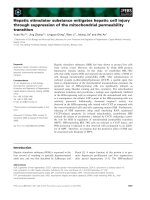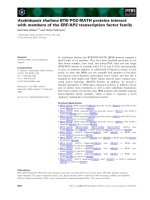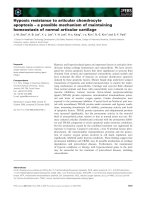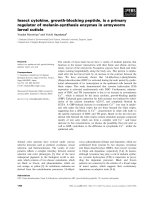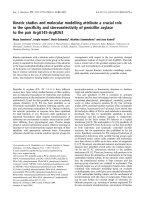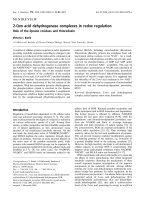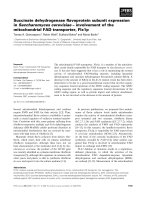Báo cáo khoa học: "Gamma knife radiosurgery for movement disorders: a concise review of the literature" ppsx
Bạn đang xem bản rút gọn của tài liệu. Xem và tải ngay bản đầy đủ của tài liệu tại đây (363.67 KB, 5 trang )
WORLD JOURNAL OF
SURGICAL ONCOLOGY
Elaimy et al. World Journal of Surgical Oncology 2010, 8:61
/>Open Access
REVIEW
© 2010 Elaimy et al; licensee BioMed Central Ltd. This is an Open Access article distributed under the terms of the Creative Commons
Attribution License ( which permits unrestricted use, distribution, and reproduction in
any medium, provided the original work is properly cited.
Review
Gamma knife radiosurgery for movement
disorders: a concise review of the literature
Ameer L Elaimy
1,4
, Benjamin J Arthurs
1,2
, Wayne T Lamoreaux
1,4
, John J Demakas
1,3
, Alexander R Mackay
1,5
,
Robert K Fairbanks
1,4
, David R Greeley
6
, Barton S Cooke
1
and Christopher M Lee*
1,4
Abstract
Medication is the predominant method for the management of patients with movement disorders. However, there is a
fraction of patients who experience limited relief from pharmaceuticals or experience bothersome side-effects of the
drugs. Deep brain stimulation (DBS) and surgical lesioning of the thalamus and basal ganglia are respected
neurosurgical procedures, with valued success rates and a very low incidence of complications. Despite these positive
outcomes, DBS and surgical lesioning procedures are contraindicated for some patients. Stereotactic radiosurgery with
the Gamma Knife (GK) has been used as a lesioning technique for patients seeking a non-invasive treatment alternative
and for medication-intolerable patients, who are unable to undergo DBS or lesioning due to comorbid medical
conditions. Tremors of various etiologies are treated using GK thalamotomy, which targets the ventralis intermedius
nucleus. GK thalamotomy produces favorable outcomes when treating tremors, with success rates ranging from 80-
100%. In contrast, GK pallidotomy targets the internal globus pallidus, and is used in treating bradykinesia, rigidity, and
dyskinesia. Although radiosurgery has proven beneficial for tremors, radiosurgical pallidotomy for bradykinesia, rigidity,
and dyskinesia remains questionable, with mixed success rates in the literature that ranges from 0-87%. We suggest
that GK thalamotomy be offered along with other neurosurgical approaches as a feasible treatment option to patients
who prefer the non-invasive nature of radiosurgery and to those who are unqualified candidates for the neurosurgical
alternatives. Also, we advise that patients with bradykinesia, rigidity, and dyskinesia be educated about the variability in
the literature pertaining to GK pallidotomy before proceeding with treatment.
Background
Pharmacotherapy is the general treatment method for
patients who suffer from movement disorders. Even
though a large proportion of patients are able to manage
their condition with medication, there is still a small
amount of patients who do not experience significant
relief from pharmaceuticals, thus, seek out other treat-
ment modalities. Deep brain stimulation (DBS) and sur-
gical lesioning of the thalamus and basal ganglia are
respected and well-studied neurosurgical procedures that
come with a low incidence of potential side-effects. How-
ever, there is a subset of patients with movement disor-
ders who are not qualified candidates for invasive
neurosurgery. This population of patients consists of
those who use anticoagulants, those who have advanced
cardiac or respiratory disease, those who are known to be
noncompliant, those who are of advanced age, and those
who elect to not proceed with neurosurgery. Despite the
fact that radiofrequency (RF) neurosurgical lesioning has
shown success in many patients, there is still a possibility
for patients to encounter a wide array of side-effects.
These include intracerebral or extracerebral hemorrhage,
seizures, infection, brain displacement, tension pnemo-
cephalus, and direct injury from probe placement [1].
Stereotactic radiosurgery using the gamma knife (GK) is a
non-invasive alternative modality for lesioning intracra-
nial structures.
The first cobalt-60-based GK device dates back to Swe-
den in 1968, where Professor Lars Leksell's intention was
to create precisely located, well-circumscribed lesions in
the brain in a minimally-invasive fashion [2]. Between
1968 and 1982, a total of 762 patients underwent treat-
ment with the cobalt-based GK unit. Only 5 of the 762
patients were treated for Parkinsonism, but this historic
study shows that the idea of treating movement disorders
* Correspondence:
1
Gamma Knife of Spokane, 910 W 5th Ave, Suite 102, Spokane, WA 99204, USA
Full list of author information is available at the end of the article
Elaimy et al. World Journal of Surgical Oncology 2010, 8:61
/>Page 2 of 5
using radiosurgical techniques is not a recent advance
and has evolved considerably over the past four decades.
In recent years, thalamotomy and pallidotomy with the
GK have been used to treat a variety of movement disor-
ders. Specifically, GK thalamotomy targets the ventralis
intermedius nucleus (VIM) of the thalamus, and is used
in treating essential, Parkinsonian, and other types of
tremors. Evidence suggests that GK thalamotomy pro-
duces favorable results when treating tremors, offering a
safe alternative to RF thalamotomy and DBS [1,3-9]. GK
pallidotomy targets the internal globus pallidus (Gpi) of
the basal ganglia, and is used in treating bradykinesia,
rigidity, and dyskinesia. However, a variety of outcomes
have been reported when using radiosurgical pallido-
tomy, thus, it remains a controversial procedure
[1,3,10,11].
We present a brief modern review of published data on
the effectiveness of GK thalamotomy and pallidotomy in
the treatment of patients with movement disorders.
Review
GK thalamotomy for tremor treatment (See Table 1 for
data summary).
In 2010, Young et al. [9] published a study analyzing
161 patients who were treated for ET with GK thalamo-
tomy. The main clinical scale utilized to assess tremor
control was the Fahn-Tolosa clinical rating scale. The
authors reported statistically significant (P < 0.0001) dif-
ferences in both drawing scores (81% of patients showed
improvements) and writing scores (77% of patients
showed improvements), with a mean follow-up of 44 ± 33
months. Overall, 14 (8.4%) patients suffered from post-
operative complications, which included limited sensory
loss contralateral to the side of the procedure, motor
impairments, and difficulties with speech. In the same
year, Lim et al. [12] investigated the role of GK thalamo-
tomy in 18 patients with disabling tremor from either ET
or Parkinson's disease (PD). The authors utilized the clin-
ical Fahn-Tolosa scale and the United Parkinson's Disease
Rating Scale (UPDRS) to assess potential tremor
improvements. Follow-up ranged from 7 to 30 months
(mean of 19.2 months). It was reported that patients sig-
nificantly improved (P = 0.03) in activities of daily living
scores. However, 3 (16.7%) patients encountered toxici-
ties from the procedure. The observed complications
from radiosurgery included edema, hemorrhage, dysar-
thria, hemiparesis, and lip and finger numbness.
In 2008, Kondziolka et al. [5] performed a study where
31 patients with ET were treated with thalamotomy using
GK radiosurgery. All patients were considered unquali-
fied candidates for neurosurgery. The Fahn-Tolosa
tremor scale was used to provide an objective measure-
ment of response to treatment. The authors reported sta-
tistically significant improvements in both the mean
tremor score (P < 0.000015) and mean handwriting score
(P < 0.0002) following radiosurgery (median follow-up of
36 months). Of the evaluated patients, 18 (69%) exhibited
improvements in their action tremor and handwriting
scores, 6 (23%) exhibited improvements in only their
action tremor, and 3 (12%) did not exhibit compelling
improvements in either variable. One patient suffered
from transient mild right hemiparesis and dysphagia,
while a separate patient also developed mild right hemi-
paresis and difficulties in their speech following radiosur-
gery.
An initial review on movement disorders was per-
formed in the past by Duma et al. [3]. Over a seven year
period, 38 patients with disabling tremor from PD under-
went thalamotomy using the GK. Patients were assessed
using the UPDRS. 42 thalamic lesions were created in
these 38 patients, and 90% were deemed successful, with
respect to tremor control. Young et al. [1] also performed
a study that evaluated the safety and efficacy of GK thala-
motomy in the treatment of tremors. The UPDRS and
Hoehn and Yahr ratings determined by trained specialists
were utilized. Overall, an 88.9% success rate was reported
in their 27 patients suffering multiple types of tremors.
More specifically, 16 patients were treated for Parkinso-
nian tremor, 8 were treated for ET, 2 were treated for
tremor following cerebral infarctions, and 1 patient was
treated for a tremor following a bout of encephalitis.
After a mean follow-up of 22.2 months, 19 patients expe-
rienced complete or nearly complete resolution of tremor
and 5 patients were nearly tremor free. Young et al. [8]
also completed an additional study investigating the long-
term effects of GK thalamotomy for disabling tremor and
obtained favorable results. Patients were evaluated by
blind evaluations, the UPDRS, and the Fahn-Tolosa
tremor scale. After a mean follow-up of 52.5 months,
88.3% of PD patients became fully or nearly tremor free.
At 12 months post-operation, 92.1% of ET patients were
fully or nearly tremor free. 88.2% of these ET patients
maintained excellent tremor control 48 months or more
following radiosurgery. Only 50% of patients with other
forms of tremor experienced notable improvements.
To compare the surgical approaches for the manage-
ment of tremor, Niranjan et al. [7] analyzed the outcomes
of patients treated with GK thalamotomy, RF thalamo-
tomy, and DBS. Out of the 13 patients that underwent RF
thalamotomy, 5 (39%) had complete arrest of tremor, 6
(46%) had a significant reduction, and 2 (15%) had
approximately 50% tremor reduction. All 11 DBS patients
experienced excellent tremor control immediately after
surgery, and it was reported that only 2 (18.2%) of those
patients' tremor reoccurred. 10 (83.3%) noted excellent
tremor relief and 2 (16.7%) experienced good relief.
Niranjan's results with GK thalamotomy correlates with
studies done by Jankovic et al. [13] and Fox et al. [14] with
Elaimy et al. World Journal of Surgical Oncology 2010, 8:61
/>Page 3 of 5
RF thalamotomy. Their reported success rates were 90%
and 91%, respectively.
GK thalamotomy is also a worthy treatment option to
consider for patients who struggle with tremors caused
by Multiple Sclerosis (MS). Mathieu et al. [6] created
radiosurgical thalamic lesions in six patients with MS-
related tremors and recorded advantageous results.
Patient results were assessed using the Fahn-Tolosa
tremor scale. After a median follow-up time of 27.5
months, it was documented that radiosurgery was benefi-
cial to every patient. Niranjan et al. [15] explored the role
of GK thalamotomy in the management of ET and MS-
related tremor in 12 patients of advanced age (median of
75 years). Patient outcomes were also assessed using the
tremor scale diagrammed by Fahn-Tolosa. Of the 11 eval-
uable patients, 9 (81.8%) reported excellent tremor con-
trol and 2 (18.2%) announced a satisfactory improvement
with their tremor.
Two issues pose potential challenges with radiosurgical
thalamotomy: the time interval between treatment and
effect and the variability of the thalamic reaction, and
inability to predict the potential subsequent side-effects
for specific patients. Both of these issues were demon-
strated in a study done to evaluate the survival of neurons
adjacent to the thalamic lesion after GK thalamotomy by
Ohye et al. [16]. They performed a total of 36 thalamoto-
mies in 31 patients and analyzed the treatment outcomes.
It was noted in this analysis that in the majority of
patients, tremor reduction started approximately one
year after irradiation. The delay in treatment effect may
not be desired by some patients. Based on MRI data, two
types of tissue reactions were observed: a simple oval
Table 1: GK thalamotomy for tremor treatment
1
st
Author (Year) # Patients (Age Range) Radiation
Dose (Gy)
Follow-up (Range) Improvement
Rate
Complications
Observed
Complication
Rate
Young [9] (2010) 161 (18-93 yrs) 141-152 Mean: 44 ± 33
months
Drawing: 81%
Writing: 77%
sensory loss, motor
impairments,
dysarthria
8.4%
Lim [12] (2010) 18 (64-83 yrs) 130-140 Mean: 19.2 months
(7-30 months)
NR edema,
hemorrhage,
dysarthria,
hemiparesis, lip
and finger
numbness
16.7%
Kondziolka [5]
(2008)
31 (52-92 yrs) 130-140 Median: 36 months
(4-96 months)
92% hemiparesis,
dysphagia,
dysarthria
7.7%
Duma [3] (1999) 38 (60-84 yrs) 120-160 Median: 30 months
(6-72 months)
90% dysarthria 2.6%
Young [1] (1998) 27 (73.3 ± 7.2 yrs**) 120-160 Mean: 22.3* months
(12-44* months)
89% none 0%
Young [8] (2000) PD: 102 (71.3 ± 8 yrs) ET:
52 (73.8 ± 9.4 yrs) Other:
4 (64.3 ± 7 yrs)
120-160 <12-96 months PD: 88.3% ET:
92.1% Other:
50%
balance
disturbance,
paresthesias,
weakness,
dysphasia
1.3%
Niranjan [7] (1999) 12 (38-78 yrs) 130-150 Median: 24 months
(4-40 months)
100% dysarthria,
weakness
8.3%
Niranjan [15] (2000) 11 (38-92 yrs) 130-150 Median: 6 months
(2-11 months)
100% dysarthria,
weakness
9.1%
Mathieu [6] (2007) 6 (31-57 yrs) 130-150 Median: 27.5 months
(5-46 months)
100% hemiparesis 16.7%
Friedman [4] (1999) 15 (37-84 yrs) 120-140 3 months 93.3% edema,
incoordination,
action tremor
46.7%
ET = essential tremor; NR = not reported; PD = Parkinson's disease
*Data includes pallidotomy patients
**Data includes only patients assessed by an independent team
Elaimy et al. World Journal of Surgical Oncology 2010, 8:61
/>Page 4 of 5
lesion and one of a complex irregular shape. There was no
correlation between the tissue reaction and tremor out-
come. Unlike DBS and stereotactic lesioning, where sub-
sequent side-effects can be predicted by neurological
physiological responses during the procedure, there are
no predictors prior to GK radiosurgery for the type of
resultant lesion observed. In some patients, the lesion
may extend into the internal capsule or medial thalamic
region, causing a variety of delayed-onset complications
months after GK radiosurgery that cannot be anticipated
[16].
GK pallidotomy for bradykinesia, rigidity, and dyskine-
sia treatment (See Table 2 for data summary).
In contrast to radiosurgical thalamotomy, controversy
exists regarding the effectiveness of GK pallidotomy for
bradykinesia, rigidity, and dyskinesia. Duma et al. [3] per-
formed a study investigating outcomes of GK pallido-
tomy. In contrast to the prior section on thalamotomy,
they reported a lack of faith in the procedure which tar-
gets the basal ganglia. Similar to the prior section on GK
thalamotomy, the authors used the UPDRS to assess
patient outcomes. A total of 18 patients underwent ste-
reotactic lesioning in the basal ganglia for bradykinesia,
rigidity, and dyskinesia related to PD. Only 6 (33%)
patients showed transient improvement in rigidity and
dyskinesia. Three (17%) patients displayed no changes,
and 9 (50%) were worsened by the treatment. The com-
plications from treatment included homonymous visual
field cuts, dysphagia, dysasthria, hemianesthesia, hemi-
paresis, and a worse gait. As with GK thalamotomy, the
size of the lesions, thus observed complications, created
by GK pallidotomy cannot be anticipated. Also, to explain
the high complication rate, the authors hypothesized that
lesion creation in the basal ganglia is more difficult than
in the thalamus due to a greater likelihood of perforating
arteries [3] In addition to arterial infarction, the authors
hypothesized that there is a differential sensitivity to radi-
ation between the VIM and Gpi. This is because the pal-
lidum has previously been known to show an increased
sensitivity to hypoxia [3]. Also, because the iron concen-
tration in the pallidum tends to increase with age, it has
been thought that the excess iron catalyzes undesirable
reactions, thus, leading to the formation of free radicals
[3]. Friedman et al. [10] witnessed outcomes with GK pal-
lidotomy comparable to that of Duma et al. [3] Only four
patients participated in the study, and none of them
exhibited compelling improvements. Complications were
seen in one patient, who became psychotic and demented
following radiosurgery.
Conversely, additional research studies from single
institutions have reported positive outcomes in radiosur-
gical pallidotomy. Young et al. [11] performed a study
comparing the outcomes of RF pallidotomy and GK palli-
dotomy for patients with PD. The UPDRS and Hoehn and
Yahr ratings were utilized. In 29 patients, the pallidoto-
mies were performed radiosurgically, and 22 patients had
the open-skull RF method performed. Before surgery, 15
of the 29 radiosurgery patients experienced dyskinesias,
and 13 (86.6%) had complete or nearly complete relief of
that symptom postoperatively. Out of the 22 RF patients,
12 experienced dyskinesia preoperatively, and 10 (83.3%)
of those patients had complete or nearly complete relief
Table 2: GK pallidotomy for bradykinesia, rigidity, and dyskinesia treatment
1
st
Author (Year) # Patients (Age
Range)
Radiation
Dose (Gy)
Follow-up (Range) Improvement Rate Complications
Observed
Complication
Rate
Duma [3] (1999) 18 (59-85 yrs) 120-160 Median: 8 months
(6-40 months)
33.3% homonymous
visual field cut,
dysphagia,
dysarthria,
hemiparesis,
hemianesthesia,
worse gait
50%
Friedman [10] (1996) 4 (61-74 yrs) 180 18 month interval 0% dementia,
psychosis
25%
Young [1] (1998) 28 (68.2 ± 10.2 yrs**) 120-160 Mean: 22.3* months
(12-44* months)
Bradykinesia/
Rigidity rate: 64.3%
Dyskinesia rate:
85.7%
homonymous
hemianopsia
3.6%
Young [11] (1998) 29 120-140 Mean: 20.6 months
(6-48 months)
Bradykinesia/
Rigidity rate: 65.5%
Dyskinesia rate:
86.6%
homonymous
hemianopsia
3.4%
*Data includes thalamotomy patients
**Data includes only patients assessed by an independent team
Elaimy et al. World Journal of Surgical Oncology 2010, 8:61
/>Page 5 of 5
after surgery. Bradykinesia and rigidity were present in
every patient preoperatively, and 19 (65.5%) of the GK
patients and 14 (63.6%) of the RF patients had significant
improvement in those symptoms. One patient in the GK
group developed a homonymous hemianopsia nine
months after treatment and five RF patients became tran-
siently confused after surgery.
Conclusions
The goal of this report is to provide a concise review of
the literature on the efficacy and potential side-effects of
GK radiosurgery in the treatment of patients with move-
ment disorders. As seen in the reported research, thalam-
otomy with the GK is an effective and non-invasive
alternative in treating tremors, with success rates ranging
from 80-100%. Additionally, because of the non-invasive
lesioning technique associated with radiosurgical thalam-
otomy, the procedure comes with a different risk profile
than the open-skull neurosurgical methods. On the con-
trary, GK pallidotomy has shown mixed outcomes in the
treatment of bradykinesia, rigidity, and dyskinesia. The
inconsistency of radiosurgical pallidotomy is demon-
strated in the available literature, with success rates that
range from 0-87%. However, studies on radiosurgical pal-
lidotomy have not been as extensive as those on radiosur-
gical thalamotomy, so less is known about the procedure
and there remains room for continued research and
improvements. We suggest that GK thalamotomy should
be mentioned as a viable treatment option to tremor
patients who prefer the non-invasive aspects of radiosur-
gery and to the fraction of medication-intolerable
patients, who are ineligible to undergo RF thalamotomy
or DBS. We also recommend that patients should be edu-
cated about the variability in the literature pertaining to
GK pallidotomy and need for further study before pro-
ceeding with radiosurgery treatment.
Competing interests
The authors declare that they have no competing interests.
Authors' contributions
ALE and CML reviewed relevant literature for this review and drafted the manu-
script. BJA, WTL, JJD, ARM, RFK, DRG, and BSC provided expertise relevant to
this review and helped draft the manuscript. All authors read and approved the
final manuscript.
Acknowledgements
We would like to acknowledge Rachel Garman and Michelle Osso, as well as
the entire Gamma Knife of Spokane and Cancer Care Northwest research staff
for their contributions to this manuscript.
Author Details
1
Gamma Knife of Spokane, 910 W 5th Ave, Suite 102, Spokane, WA 99204, USA,
2
University of Washington School of Medicine, 325 9th Ave, Seattle, WA 98104,
USA,
3
Spokane Brain & Spine, 801 W 5th Ave, Suite 210, Spokane, WA 99204,
USA,
4
Cancer Care Northwest, 910 W 5th Ave, Suite 102, Spokane, WA 99204,
USA,
5
MacKay & Meyer MDs, 711 S Cowley St, Suite 210, Spokane, WA
99202,USA and
6
Northwest Neurological PLLC, 507 S Washington St, Suite 101,
Spokane, WA 99204, USA
References
1. Young RF, Shumway-Cook A, Vermeulen SS, Grimm P, Blasko J, Posewitz A,
Burkhart WA, Goiney RC: Gamma knife radiosurgery as a lesioning
technique in movement disorder surgery. J Neurosurg 1998, 89:183-193.
2. Leksell L: Stereotactic radiosurgery. J Neurol Neurosurg Psychiatry 1983,
46:797-803.
3. Duma CM, Jacques D, Kopyov OV: The treatment of movement
disorders using Gamma Knife stereotactic radiosurgery. Neurosurg Clin
N Am 1999, 10:379-389.
4. Friedman DP, Goldman HW, Flanders AE, Gollomp SM, Curran WJ Jr:
Stereotactic radiosurgical pallidotomy and thalamotomy with the
gamma knife: MR imaging findings with clinical correlation
preliminary experience. Radiology 1999, 212:143-150.
5. Kondziolka D, Ong JG, Lee JY, Moore RY, Flickinger JC, Lunsford LD:
Gamma Knife thalamotomy for essential tremor. J Neurosurg 2008,
108:111-117.
6. Mathieu D, Kondziolka D, Niranjan A, Flickinger J, Lunsford LD: Gamma
knife thalamotomy for multiple sclerosis tremor. Surg Neurol 2007,
68:394-399.
7. Niranjan A, Jawahar A, Kondziolka D, Lunsford LD: A comparison of
surgical approaches for the management of tremor: radiofrequency
thalamotomy, gamma knife thalamotomy and thalamic stimulation.
Stereotact Funct Neurosurg 1999, 72:178-184.
8. Young RF, Jacques S, Mark R, Kopyov O, Copcutt B, Posewitz A, Li F:
Gamma knife thalamotomy for treatment of tremor: long-term results.
J Neurosurg 2000, 93(Suppl 3):128-135.
9. Young RF, Li F, Vermeulen S, Meier R: Gamma Knife thalamotomy for
treatment of essential tremor: long-term results. J Neurosurg 2010,
112:1311-1317.
10. Friedman JH, Epstein M, Sanes JN, Lieberman P, Cullen K, Lindquist C,
Daamen M: Gamma knife pallidotomy in advanced Parkinson's disease.
Ann Neurol 1996, 39:535-538.
11. Young RF, Vermeulen S, Posewitz A, Shumway-Cook A: Pallidotomy with
the gamma knife: a positive experience. Stereotact Funct Neurosurg
1998, 70(Suppl 1):218-228.
12. Lim SY, Hodaie M, Fallis M, Poon YY, Mazzella F, Moro E: Gamma knife
thalamotomy for disabling tremor: a blinded evaluation. Arch Neurol
2010, 67:584-588.
13. Jankovic J, Cardoso F, Grossman RG, Hamilton WJ: Outcome after
stereotactic thalamotomy for parkinsonian, essential, and other types
of tremor. Neurosurgery 1995, 37:680-686. discussion 686-687
14. Fox MW, Ahlskog JE, Kelly PJ: Stereotactic ventrolateralis thalamotomy
for medically refractory tremor in post-levodopa era Parkinson's
disease patients. J Neurosurg 1991, 75:723-730.
15. Niranjan A, Kondziolka D, Baser S, Heyman R, Lunsford LD: Functional
outcomes after gamma knife thalamotomy for essential tremor and
MS-related tremor. Neurology 2000, 55:443-446.
16. Ohye C, Shibazaki T, Ishihara J, Zhang J: Evaluation of gamma
thalamotomy for parkinsonian and other tremors: survival of neurons
adjacent to the thalamic lesion after gamma thalamotomy. J Neurosurg
2000, 93(Suppl 3):120-127.
doi: 10.1186/1477-7819-8-61
Cite this article as: Elaimy et al., Gamma knife radiosurgery for movement
disorders: a concise review of the literature World Journal of Surgical Oncology
2010, 8:61
Received: 8 January 2010 Accepted: 21 July 2010
Published: 21 July 2010
This article is available from: 2010 Elaimy et al; licensee BioMed Central Ltd. This is an Open Access article distributed under the terms of the Creative Commons Attribution License ( which permits unrestricted use, distribution, and reproduction in any medium, provided the original work is properly cited.World Journal of Surgical Oncology 2010, 8:61
